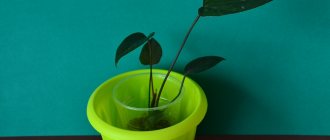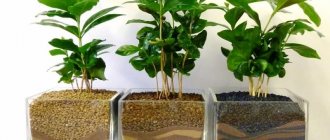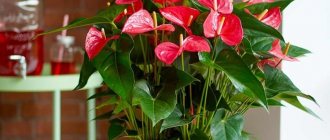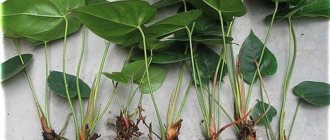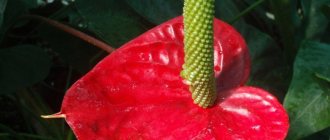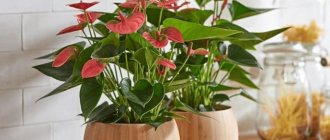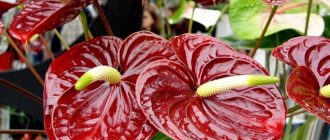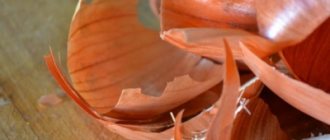How to rejuvenate an anthurium at home - the need for such a procedure sooner or later arises when the flower gets older and certain measures are needed to ensure that it preserves its beauty and its unusual exotic appearance for as long as possible.
Since this original plant with oblong bright flowers and leaves of an original shape is liked by so many, it is important to know what the so-called rejuvenation process includes, which is not difficult to do on your own.
Why is rejuvenation necessary?
The older the anthurium gets, the less beautiful it becomes. The lower leaves gradually die off, exposing the unattractive trunk of the plant. Leaves and flowers become increasingly smaller, often growing with curled tips. Sometimes the flowering of anthurium stops completely.
If a flower has lost its decorative appearance and began to wither, then in order to revive it to a new life and again admire the chic flowers of “male happiness”, it is necessary to carry out a rejuvenation procedure.
Botanical description
Anthurium is native to South America. It has about 80 hybrids and about 30 subspecies. This plant was introduced in the 19th century. and became very popular in a short time.
The most important and unusual thing about Anthurium is its flower. It has the original appearance of cobs of yellow and white shades, which are framed by bedspreads of various colors, from pink to deep red.
Anthurium leaves can grow up to 40 centimeters. They are quite long and heart-shaped.
The flowering period of Anthurium is more than six months, from March to November. After this, he has a short rest, after which the flowering period begins again. But this happens only when the plant is properly and properly cared for.
Anthurium can grow up to 80 centimeters at home.
How often should the male happiness flower be renewed?
A plant that is not yet three years old does not require updating.
As it gets older, the anthurium begins to degrade: the roots and leaves die off, and the plant begins to wither. Growth and development are suspended. Different types of “male happiness” require rejuvenation at different ages, which can be determined by their appearance. As a rule, anthurium that is 4-5 years old needs resuscitation. You can rejuvenate at least every year, but it is best to prune once every 3-4 years. The most favorable time for flower renewal is considered to be from May to June. In summer it is warm and the plant has time to sprout roots before the first cold weather and short daylight hours.
How does it grow in nature, where is it found?
Most plants grow in Central and South America. Tropical and subtropical latitudes are ideal for anthurium .
The highest, northern point of the habitat of this plant is Mexico, and the southernmost point is Paraguay and Argentina. Except in these places, anthurium feels great on the Caribbean islands. You can also find this flower in the foothills of the South American Andes and the Central American Cordilleras.
Several species of this plant can be found even in savannas. Anthurium is found in a wide range of altitudes - from sea level to almost 3.5 kilometers above sea level.
When should you start updating?
To understand that anthurium needs pruning and rejuvenation, just examine it carefully. In an aging plant, as the lower leaves die off, an unsightly trunk is exposed.
Unlike young anthurium, the leaves and flowers of the old plant become small, many side shoots appear and “male happiness” turns into a bush with small flowers, and eventually stops blooming altogether. All these signs indicate that the flower should be rejuvenated.
Anthurium propagation methods
To propagate the plant, wait until the anthurium reaches maturity. There are several methods of reproduction, each of which has certain subtleties and nuances.
Daughter plants
The method is quite simple and guarantees almost 100% results. It is better to carry out the procedure at the time of transplanting the anthurium.
Pre-prepare small containers with soil for planting sprouts. Immediately after removing the adult plant from the pot, carefully separate the young shoots along with the roots and plant them in molds. Young anthuriums should be cared for in the same way as adults. If the root system of the shoots is not sufficiently developed, it can be grown in a mixture of overwater and sand.
Apical cuttings
Reproduction in this way is possible only during the period when the plant is not blooming. Procedure:
- Prepare the substrate by mixing peat and sand in equal proportions.
- Cut the apical stalk 5 to 8 cm long.
- Ventilate the cutting for no more than 5 minutes, and then root it in the substrate.
- Cover containers with sprouts with polyethylene, creating a greenhouse effect.
- Moisten the sand-peat mixture daily and ventilate the sprouts.
Some gardeners dip the cuttings into settled water, where they are also able to take root.
Seed propagation
The peculiarity of planting anthurium seeds is the quality of the material. Only fresh seeds can sprout. If you have the opportunity to buy fresh seeds or collect seeds from your plant, you can safely use this propagation method.
If you want to collect seeds from your plant, be prepared for the process to take a very long time.
First of all, in order for fruits with seeds to appear, the flowering plant must be pollinated. Transfer pollen from the stamens to the pistils of the flower with a soft brush and repeat the procedure after a few days to ensure uniform maturation of the buds.
If you do everything correctly, in 6–8 months you will see fruits on the plant. The seeds are considered ripe after the fruits have changed color. Remove them from the fruit and dry them for several days.
After drying, the seeds can be planted. For this:
- Prepare a small, wide container and loose soil, such as peat.
- Carefully transfer the seeds into the soil and sprinkle with a thin layer (no more than 3 mm) of substrate.
- Moisten the surface of the soil with seeds using a spray bottle.
- Place the containers in a bright place, away from direct sunlight, covering them with polyethylene. The air temperature should be kept between 20 and 24 degrees.
- Spray the soil and ventilate the crops daily.
You will notice the first buds after 7–14 days, and a leaf after about 4–5 weeks. When 3 leaves appear on the shoot, the seedlings should be planted in separate forms.
Step-by-step rejuvenation procedure
It is necessary to rejuvenate “male happiness” in the following way:
- Cut off the upper part of the stem, which has aerial roots, 12-15 cm high, and remove the leaves, leaving two leaves on the cutting.
- At the bottom of a plastic cup with a volume of 200-500 ml, make several holes for water to drain and pour vermiculite into it, filling 1/3 of the container.
- Plant the cut part of the stem into a glass, deepening it by 5 cm, sprinkling vermiculite on top.
- Moisten the vermiculite, spray the leaves, and cover the top with a glass jar, plastic wrap or the cut-off bottom of a plastic bottle so that constant moisture is maintained inside - this will facilitate faster rooting of the plant.
- Place the greenhouse in a bright place, and if there is not enough light, then under a special lamp, maintaining a temperature of 22-24 degrees.
- The planted cuttings must be sprayed daily with soft warm water, the greenhouse must be ventilated, and the vermiculite must not be allowed to dry out.
- The first roots begin to sprout after 20-25 days. When new leaves appear and the roots grow by 3 cm (in one and a half to two months), the greenhouse is dismantled and the rejuvenated plant is planted in a permanent pot with soil.
If after cutting the top there is a trunk and roots left, then do not rush to throw them away. You can try to revive “men's happiness”. To do this, you need to continue to care for the remaining “stump” and reduce watering, since there is no need to feed the leaves. Often, dormant buds wake up on an old plant, from which young shoots develop, and under them - aerial roots.
When the roots grow to 1.5 cm in length, the flower can be transplanted into a new substrate, resulting in another updated anthurium.
Types of anthurium
As already mentioned, the anthurium family has more than 800 species. The most popular have become several varieties that are distinguished by their lush and variegated flowering.
| Variety | Brief characteristics |
| Anthurium Andre | One of the most popular types. It is distinguished by a bright periflower blanket of red, less often white tones. It has a glossy surface with faint wrinkles. The appearance of the leaves is shaped like a heart, about 30 cm long and 12 cm wide. The leaf is attached to a long petiole. The inflorescence itself has the shape of a light-colored cob. Among the variety of indoor plants there is also the Anthurium Andre Champion variety, which is distinguished by more voluminous flowering. |
| Anthurium Scherzer | One of the most famous indoor species. It has a yellow or orange cob color surrounded by a red-orange spathe. The bright sheet has a not too dense structure with a varnished surface. The leaves are oval or lanceolate in shape with a sharp apex. Painted dark green. The surface below is matte, the surface above is glossy. They are located on petioles from 5 to 20 cm long. |
| Anthurium crystal | It is distinguished by the original color of the leaves, against a dark green background of which silver-white veins stand out. The leaves with a pointed apex are large, approximately 40 cm long. The small perianth leaf is almost invisible, as it is also colored green. The inflorescence has the shape of a yellow spadix. |
| Baker's Anthurium | A plant with narrow green oval-lanceolate leaves, reaching a length of about 50 cm. The flowers are very small and are located below the foliage level. The bedspread is painted yellow-green with purple edging. |
| Anthurium mix | A hybrid plant variety bred from the popular species Anthurium Andre and Anthurium Scherzer. It has a more compact size and abundant flowering. Such hybrids are more adapted to home growing conditions. |
Photos of flowers after resuscitation
Why doesn't Anthurium bloom?
If your beloved pet does not want to please you with its flowering, then you have made a mistake somewhere in caring for it. Errors to watch out for:
Charming tomatoes that will decorate any dish - the Geranium Kiss tomato: description of the variety and its characteristics
1. The room is too cold for Anthurium. A temperature of 15 degrees is extremely uncomfortable for the plant.
2. Poor lighting.
3. The container is too spacious for Anthurium.
4. Overdose of mineral fertilizers. This will be indicated first of all by the blackened tips of the leaves.
5. Unsuitable or poor quality soil. In this case, try to transplant the plant into another pot.
6. Bay of plants. In this case, its leaves may acquire a distinct yellow tint.
The last two factors may also indicate a fungus that has settled on the plant.
Care after pruning
After pruning and rejuvenation, the plant requires the same care as for a newly transplanted anthurium:
- The ambient temperature should be from 18 to 22 degrees;
- place the plant away from drafts;
- place the flowerpot in a well-lit place, but not in direct sunlight;
- Water the anthurium regularly, but do not over-moisten the soil;
- Provide good drainage to remove excess water.
If you follow simple rules of care, updating an old anthurium will be successful, even if what remains of the gorgeous flower is a trunk with several leaves.
Transfer
Throughout its life, the plant requires regular replanting. Your actions must be careful and careful not to injure the delicate roots of the anthurium.
When to replant anthurium
First of all, replant the anthurium immediately after purchase, since store-bought substrate may contain excessive amounts of minerals and carcinogens.
Subsequent transplants will be required as the root system grows. For young plants, the frequency of transplants is 1 time per year. It is advisable to replant flowers that have reached four years of age at least once every 3 years.
Also, replanting or replacing the soil will be required if the anthurium gets sick.
Choosing a pot
Choose a pot depending on the base of the transplant. For example:
- if the root system has occupied the entire substrate, choose a container 2–3 cm larger than the previous one;
- if new shoots are needed, choose a wider vessel;
- for abundant flowering when replanting, take a form that is larger in size than the old one by a maximum of 2 cm;
- For planting young shoots, use small 200 ml cups.
There must be holes at the bottom of the pot for drainage.
Before use, be sure to disinfect the container with soapy water or pour boiling water over it.
Land for replanting
For replanting, use a soil type suitable for anthurium. You can buy a ready-made mixture or prepare the substrate yourself.
Anthurium transplant after purchase
Perform the procedure approximately 4–5 days after purchase. This time will be enough to acclimatize the plant.
Action plan:
- Water the soil thoroughly.
- If the pot is plastic, knead it a little so that the substrate moves away from the walls.
- Carefully remove the root ball from the container.
- If possible, remove any old soil from the root hairs.
- Carefully inspect the roots for damage and rotting.
- Fill the new form with a drainage layer, such as expanded clay.
- Fill the drainage with new soil.
- Place the plant in the pot and cover it with soil, leaving 2-3 cm to the edge of the container.
- Lightly compact the substrate.
When replanting to replace soil, the roots are completely cleared of soil. To make the soil move away from the hairs more easily, briefly soak the root ball in water.
Is it possible to replant a flowering plant?
Despite the fact that most plants do not survive transplantation during flowering, anthurium survives the procedure quite well. During replanting, pay utmost attention to both the integrity of the root hairs and the flowers.
Transplanting a diseased anthurium
If the leaves of the anthurium turn yellow, become deformed or wither, then the functioning of the root system has been disrupted. To revive the plant, you will have to replant the flower and replace the soil.
The procedure is no different from a regular transplant. However, during the procedure, pay special attention to clearing the rhizome from soil and processing the hairs. Carefully examine the roots and remove diseased and rotten parts. Treat the remaining hairs with Actellik. Also separate yellow and wilted leaves from the bush.
What to do after transplant
To ensure that anthurium takes root in a new substrate, follow the following recommendations:
- in the first 15–20 days, water less often than usual so that the roots do not rot from excess moisture;
- during the same period, do not add any fertilizers to the soil;
- provide the plant with optimal temperature conditions ranging from 20 to 22 degrees;
- do not place the flower in places exposed to direct sunlight;
- Spray the surface of the sheets with settled water daily.
If the plant is large, strengthen the stems by tying them to a support.
What to do if the plant withers after the procedure?
If the plant was pruned correctly and its rooting was successful, but the anthurium soon began to wither, then some mistakes may have been made in caring for the renewed plant.
A renewed plant may begin to wither if:
- it is exposed to direct sunlight or, conversely, insufficient lighting;
- high room temperature and dry air;
- excess nitrogen fertilizers;
- excessive or insufficient watering.
When all these problems are eliminated, the plant should return to normal and begin to grow. If the leaves still do not rise, then we can assume that the flower was infected with chlorosis or fusarium during transplantation. In the first case, iron should be added when applying fertilizer, and in the second, the anthurium should be treated with fungicides.
Attention! Sudden changes in air temperature, as well as drafts, should not be allowed - this can cause the plant to die.
The procedure for rejuvenating a plant does not require significant effort, and all of the above tips will help you avoid typical mistakes of a novice gardener.
Landing rules
Let's consider a scheme of actions that will allow you to grow an attractive, strong plant:
- For planting, special attention must be paid to the selection of soil. The soil should consist of two types: leaf soil and peat. To make the soil loose, add coarse sand in small quantities.
- Additionally, broken brick and charcoal are added, this allows the soil to be well saturated with moisture. Add 100 grams of drainage per kilogram of soil.
- He loves space, so you need to choose appropriate flowerpots. If there is not enough space for the roots, the soil will oxidize and inflorescences will not form.
- Plant in the center of the pot, the root system should be located four centimeters below the top of the pot. The root is gradually covered with soil to a depth of two centimeters, the remaining two centimeters are covered with sphagnum.
- Everything is well sealed to avoid air cushions. To do this, you can shake the pot a little and knock on it.
- Anthurium is watered and sprayed with a growth stimulator.
Landing completed. Next, choose a suitable place for placement, avoid direct sunlight and drafts.
Let's watch an interesting video about caring for the male happiness flower:
Solving problems and difficulties during cultivation
While growing anthurium, you may encounter some problems and difficulties, the timely solution of which will help cure and restore the plant.
Why do the leaves dry out and turn yellow?
Yellowness and dryness of the leaves indicate that the plant is either in a draft or simply frozen. By restoring the temperature regime and moving the pot to another place, you will bring the flower back to life.
Why do anthurium leaves crack?
If the leaves are cracked, then the soil or the quality of the water used for irrigation is not suitable for the plant. The flower should not be watered with fresh running water. Before watering, the liquid must stand in the room for at least a day.
Why doesn't anthurium bloom?
Lack of flowering can be caused by insufficient lighting, disturbed temperature conditions and lack of fertilizing. Simply fertilize the soil and move the pot to a suitable room with more light. Also, anthurium may not bloom if its root system is significantly smaller in volume than the substrate. In such a case, simply transplant the plant into a smaller pot.
What to do if there are brown spots on the leaves
There may be several reasons for this phenomenon:
- excessive watering;
- incorrectly selected soil;
- the plant is too hot and dry (the tips of the leaves darken);
- anthracnose fungus (there is a small black dot in the center of the spot).
Once proper care is restored, the stains will go away. If the flower is infected with fungus, spray the leaves with an antifungal agent, following the instructions on the package.
If the leaves have darkened completely, it means that you are watering the anthurium with too cold and unsettled water.
How to update an old anthurium
As the anthurium grows, old leaves die off and new ones form on top. Due to this phenomenon, the flower loses its presentable appearance. To restore the plant's attractiveness, cut off and root the top. The procedure is convenient to do during transplantation.
Why do Anthurium flowers turn green?
For some varieties this is a natural process that occurs at the end of flowering. If you carefully remove the green flowers, it will be easier for the plant and it will bloom again faster. If the process is regular, the rules of care may have been violated, and if restored, the problem will go away.
If the roots have rotted, how to save the anthurium
If the roots are completely rotten, try to restore the plant by rooting cuttings. Perform all actions in the same way as during reproduction.
Why does anthurium grow poorly?
If the anthurium begins to grow slowly, think about whether you have changed its location, due to which the quality of lighting or watering has changed. Mineral fertilizers and fertilizing, as well as the resumption of proper watering and lighting levels, will help restore the flower.
Why does anthurium have small leaves and flowers?
With a similar phenomenon, anthurium indicates a lack of nutrients, moisture or lighting. Feed the plant, restore watering and lighting, and the flower will grow.
Why does anthurium wither?
It happens that the flower begins to emit an unpleasant odor. The problem can be caused by either hypothermia of the plant or fsarium disease, which appears from an excess of liquid, as well as infection from pets or dirty hands.
How often does anthurium bloom?
Anthurium blooms for more than six months, resting only in the harsh winter. The first flowers bloom as early as March and can remain on the stems for several months. When cut, anthurium flowers can last in water for about a month.
Growing an anthurium is not difficult if you follow all the subtleties of care: install the flower in a suitable place, regularly feed and replant, and observe watering standards. The plant reacts instantly to any violation of the regime. Before purchasing an anthurium, consider whether you can provide the flower with proper care.
Diseases and pests
Anthurium is susceptible to various types of infections and pests.
Pests can be:
- spider mite;
- mealybug;
- aphid;
- scale insect
Insecticide solutions provide a good effect, however, it is advisable to remove some parasites manually in addition to spraying. For example, the scale insect is so tenacious that, having fallen into the ground after etching, it can after some time be restored to life and again parasitize the above-ground part of the plant.
The most destructive diseases are:
- Root rot . When there is an excess of moisture, pathogenic bacteria attack the root system. The roots stop supplying nutrients to the above-ground part of the plant. The stems and leaves dry out, darken and die without a chance of salvation.
- Stem rot. Overmoistening as a result of flooding the soil clod and too frequent spraying leads to rotting of the stems. Softening and darkening of the stem and leaves indicate that reviving such a plant will not be easy. Many gardeners say that we will revive such a plant first, which will give a chance for the flower to be restored.
- Anthracnose. If the infection is severe, the leaves begin to dry out at the edges, and as the disease progresses, the dying anthurium can no longer be saved; the entire above-ground part becomes depleted and dies. Resuscitation of a flower affected by anthracnose is possible only in the first stages of the disease.
- Blackening of leaf tips . The disease is caused by an excess of calcium salts in the soil. By balancing the acidity and composition of the soil, the development of the disease can be stopped, however, restoring the decorative appearance of the plant will not be easy.
- Curling of leaves. The leaves give the anthurium a special sophistication. Therefore, when they begin to disappear, the flower takes on a pitiful appearance. The most likely causes may be dry hot air, frequent drafts, lack or too high activity of sunlight. As soon as the root cause can be eliminated, there is a chance to revive the anthurium at home.
Signs
The plant has long been endowed with many signs. It has been noticed that in a house in which anthurium grows, the level of positive energy increases significantly. The flower fills the house with harmony, enhances the intuition of its inhabitants, and encourages them to make important decisions.
In some countries, it is customary to give anthurium to young couples for a wedding , since such a gift, according to signs, gives the groom the masculine strength necessary for a happy start to family life.
You will learn more about the signs associated with anthurium from this video:
